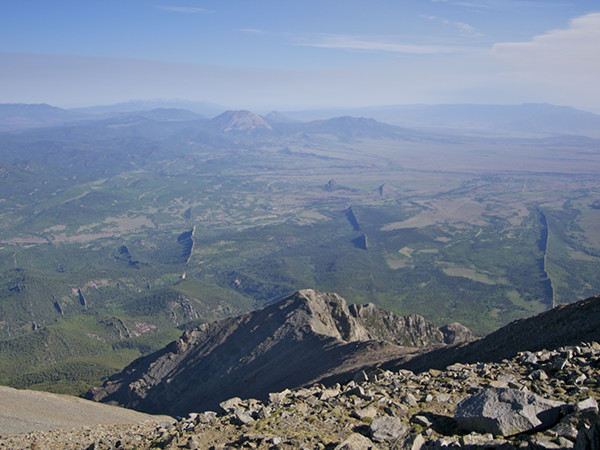
by The American Geosciences Institute Wednesday, June 28, 2017

Click to enlarge photo.
This mountain peak offers striking views of numerous linear dikes that appear to radiate from the mountain, which is part of a range that straddles two states and has a biblically bloody name.
The mountain is the remnant of an igneous stock composed mainly of quartz syenite and monzonite, which intruded roughly 25 million years ago into existing sedimentary rock layers. These layers have since eroded to leave part of the stock exposed.
At about 4,155 meters, or 13,632 feet, the mountain is not among the more than 50 “fourteeners” in this state, although it is the easternmost 4,000-meter-plus peak in the U.S., and it’s the taller in a pair of similarly named adjacent peaks.
Scroll down for the answer
Answer: At 4,155 meters, West Spanish Peak is the taller of Colorado’s two Spanish Peaks, part of the Sangre de Cristo Range that extends into New Mexico. It is a remnant of an igneous stock composed mainly of quartz syenite and monzonite, which intruded roughly 25 million years ago into now-eroded sedimentary rock layers. Photo is by Mary Caperton Morton. July 2017 Winners: Mike Bernard (Salt Lake City, Utah) Ann Coppin (Westminster, Calif.) Pete Ismail (Pasadena, Md.) Steve Spear (Carlsbad, Calif.) Daniel Tucker (Sun Lakes, Ariz.)
Visit the ‘Where on Earth?’ archive.
EARTH also welcomes your photos to consider for the contest. Learn more about submitting photos.
© 2008-2021. All rights reserved. Any copying, redistribution or retransmission of any of the contents of this service without the expressed written permission of the American Geosciences Institute is expressly prohibited. Click here for all copyright requests.